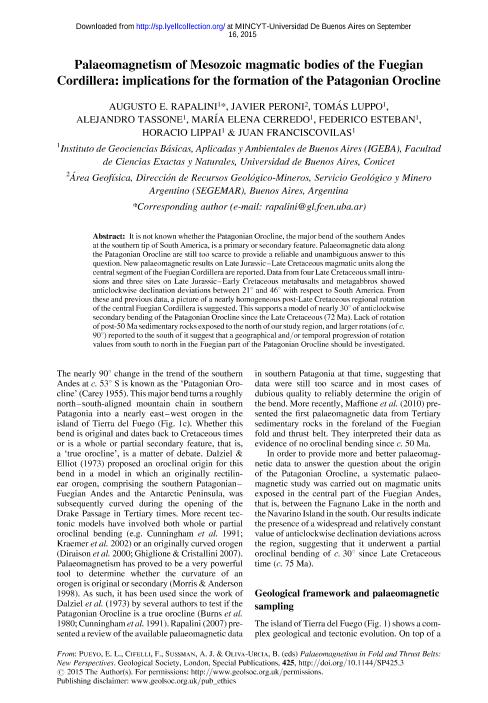Artículo
Palaeomagnetism of Mesozoic magmatic bodies of the Fuegian Cordillera: implications for the formation of the Patagonian Orocline
Rapalini, Augusto Ernesto ; Peroni, Javier Ignacio
; Peroni, Javier Ignacio ; Luppo, Tomas
; Luppo, Tomas ; Tassone, Alejandro Alberto
; Tassone, Alejandro Alberto ; Cerredo, Maria Elena
; Cerredo, Maria Elena ; Esteban, Federico Damián
; Esteban, Federico Damián ; Lippai, Horacio Francisco
; Lippai, Horacio Francisco ; Vilas, Juan Francisco A.
; Vilas, Juan Francisco A.
 ; Peroni, Javier Ignacio
; Peroni, Javier Ignacio ; Luppo, Tomas
; Luppo, Tomas ; Tassone, Alejandro Alberto
; Tassone, Alejandro Alberto ; Cerredo, Maria Elena
; Cerredo, Maria Elena ; Esteban, Federico Damián
; Esteban, Federico Damián ; Lippai, Horacio Francisco
; Lippai, Horacio Francisco ; Vilas, Juan Francisco A.
; Vilas, Juan Francisco A.
Fecha de publicación:
07/2015
Editorial:
Geological Society of London
Revista:
Geological Society of London Special Publication
ISSN:
0305-8719
Idioma:
Inglés
Tipo de recurso:
Artículo publicado
Clasificación temática:
Resumen
It is not known whether the Patagonian Orocline, the major bend of the southern Andes at the southern tip of South America, is a primary or secondary feature. Palaeomagnetic data along the Patagonian Orocline are still too scarce to provide a reliable and unambiguous answer to this question. New palaeomagnetic results on Late Jurassic–Late Cretaceous magmatic units along the central segment of the Fuegian Cordillera are reported. Data from four Late Cretaceous small intrusions and three sites on Late Jurassic–Early Cretaceous metabasalts and metagabbros showed anticlockwise declination deviations between 218 and 468 with respect to South America. From these and previous data, a picture of a nearly homogeneous post-Late Cretaceous regional rotation of the central Fuegian Cordillera is suggested. This supports a model of nearly 308 of anticlockwise secondary bending of the Patagonian Orocline since the Late Cretaceous (72 Ma). Lack of rotation of post-50 Ma sedimentary rocks exposed to the north of our study region, and larger rotations (of c. 908) reported to the south of it suggest that a geographical and/or temporal progression of rotation values from south to north in the Fuegian part of the Patagonian Orocline should be investigated.
Palabras clave:
Paleomagnetism
,
Mesozoic
,
Fuegian Cordillera
,
Patagonian Orocline
Archivos asociados
Licencia
Identificadores
Colecciones
Articulos(IGEBA)
Articulos de INSTITUTO DE GEOCIENCIAS BASICAS, APLICADAS Y AMBIENTALES DE BS. AS
Articulos de INSTITUTO DE GEOCIENCIAS BASICAS, APLICADAS Y AMBIENTALES DE BS. AS
Citación
Rapalini, Augusto Ernesto; Peroni, Javier Ignacio; Luppo, Tomas; Tassone, Alejandro Alberto; Cerredo, Maria Elena; et al.; Palaeomagnetism of Mesozoic magmatic bodies of the Fuegian Cordillera: implications for the formation of the Patagonian Orocline; Geological Society of London; Geological Society of London Special Publication; 425; 7-2015; 65-80
Compartir
Altmétricas



